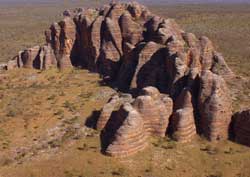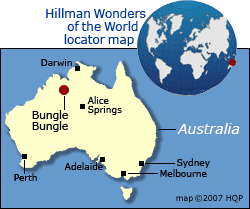Bungle Bungle
 Why
Bungle Bungle
is special
Why
Bungle Bungle
is specialBungle Bungle has bee-hive shaped sandstone domes that soar up to hundreds of feet high. But what makes this Australia travel wonder most exciting are the mound's alternating horizontal stratified bands - orange, gray and black. Photo shows just one of the many dome groups.
Bungle Bungle tips & insights
Other Bungle Bungle features
In addition to the renowned domes, there are high-wall, palm-adorned, dry-creek gullies for hiking. The Bungle Bungle of Australia also has Aborigine rock paintings and burial grounds.
Best time to visit
May to October (the Southern Hemisphere winter) is best. May is the finest of all because it follows the wet season, which means that the otherwise barren landscape will be alive with green vegetation, colorful wild flowers, and small pools.
Least desirable time to visit
From late November through early April, days are likely to be uncomfortably hot, humid and rainy. And the park is closed for several months during the middle of that period.
Few knew of it 30 years ago
Bungle Bungle lies in a remote and, until recently, difficult-to-reach wilderness area. That helps explain why it was unknown (except to some local Australians, mainly Aborigines) until the 1980s.
Sightseeing today
Some travelers explore Bungle Bungle using 4WDs and their feet. They get to enjoy Bungle Bungle up close. Others visitors sightsee by plane or helicopter. The chief advantage is you see a greater variety of the Bungle Bungle landforms than you could on the ground. For the keenest perspective of Bungle Bungle, view it from both the air and ground.
Two sections
Bungle Bungle is unofficially divided into two sections: Northern and Southern.
-
Northern
It boasts Echidna Chasm, which offers a popular 1-hour hike through its high, narrow gorge.
- Southern
This is the more alluring section because it has the bee-hive mounds. Its two best known hikes are through the Cathedral Gorge (1 hour) and the Piccaninny Creek (8 to 10 hours).
The sandstone terrain was eroded into beehive-forms in the last 20 million years by fierce winds and flash floods.
Colorization
The gray and black bands get their hue from a lichen fungus (with the help of algae).
The orange layers are less porous to water. Because fungi need water, those layers are poor hosts to them. Therefore, instead of being blackened by lichen, they are colored by orange-hued silica crystalline compounds.
Climbing
The sandstone mounds appear hard, but are fragile and easily crumbled, so scaling them is prohibited.
Name
Bungle Bungle is the name for a portion of the Purnululu National Park that contains the remarkable rock landforms.
Location in Australia



